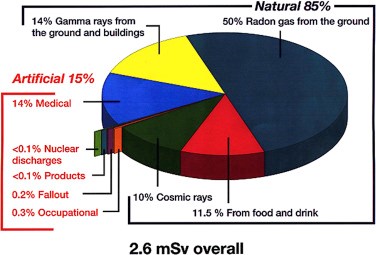When people are asked to identify their preferred power generating options from a list of coal, hydro, nuclear, solar and wind power, their first choice is usually solar, followed by wind, hydro and then coal. Often, nuclear power, the most effective option, is placed last or forgotten altogether. Most people have a fear of nuclear power and radiation. Is this fear rational or irrational?
Unbeknownst to many, we have been exposed from the time of creation to radiation. Scientists have gained a better understanding about radiation over the last 100 years and now know that doses of radiation encountered in the environment are low, and so not harmful. Places with high levels of radiation are linked to the amount of uranium or thorium deposited in those areas.
The Wellness spas built in hot springs areas, in Japan, Europe and in North America for example, are very popular thriving health care businesses. The hot springs were also popular in the past; it was the ancient Romans who developed, some 2000 years ago, the hot spring baths at Baden-Baden and Bath, which are still hugely popular in Germany and the UK respectively. The Romans cherished the hot springs for their healing properties as well as for relaxation and rejuvenation.
It is now well known that the hot spring waters contain many chemical elements in different combinations and that they are radioactive, due to radioactive radon, a progeny of uranium and thorium. Since radon is gaseous, it permeates through rocks and soil into the hot springs. The warmer the waters, the greater is the amount of uranium or thorium in the area. It is obvious that radiation levels at functioning Spas are tolerable, since environmental protection agencies and health authorities have not declared them as ‘No Go Areas’. Many people who frequent Wellness Spas do so knowing that the water is radioactive; joyfully soaking themselves in soothing warm water, which has remedies for diverse ailments such as skin infections, muscles and joint problems, blood pressure and other ailments.
A study of radiation exposure in the US in the attached diagram (Figure 1 The Annual Radiation Exposure in the US) provides a clear case study to help allay irrational fears about radiation. An ionizing radiation is a type of radiation that causes damage to human body, and all the types of radiation given in the diagram, are ionizing radiation.
Note that radiation can be derived from natural sources: Radon-50%, Gamma- rays from the Earth and Building Materials -14%, Food and Drink-11.5%, and Cosmic Rays-10%. These natural sources together account for about 85% of the annual radiation in the US. The terms “Gamma-rays” and “Radon” can be understood to mean “radiation” and “radiation in the air we breathe” respectively. We will expand on these terms in our next series.
In certain publications, ‘Food and Drink’ are represented by the human body, which contains infinitesimal amounts of many elements, including of uranium and radium. Potassium-40 and carbon-14 alone, account for 92% of the radiation in our bodies. The former is found in nutritious fruits and vegetables such as bananas, plantains, avocados, spinach, white and black beans, coconut-water, watermelon, sweet potatoes and others, while carbon-14 is found in carbohydrates. It is interesting to add that carbon-14 devices are used by archeologists for much better estimation of historic artefacts.
In addition, cosmic rays originating from outer space account for about 10% of the annual dose of background radiation in the US. Anyone whose career is in aviation – in particular pilots and flight attendants – are more exposed to radiation than nuclear power operators.
It is also worth noting that of the 15% man-made radiation sources, hospitals alone account for 14%, covering radiations from X-rays and Nuclear Medicine, using devices like mammograms, and CT (computed tomography) and other devices for diagnostic and therapeutic purposes. Radiation is also used to sterilize surgical instruments, creams, bandages, infusions, and several other vital items. Note that the share of nuclear power in the annual dose received by the general public in the USA is less than 0.01%.
Of the natural sources of radiation, radon is the most worrisome, and it varies greatly from a place to another, according to the deposits of uranium and/or thorium in the area. Such areas are meticulously mapped out by Americans and Europeans. Fig 2 shows a Radon Map of the USA, showing several levels of radon intensities depicted in colours. The first four States with the highest levels are Alaska, followed by South Dakota, Pennsylvania and Ohio, while Hawaii has the least levels of radon, followed by Louisiana, Mississippi and Florida.
The following website provides key data on radiation exposure with a US focus: https://www.pbs.org/wgbh/pages/frontline/shows/reaction/interact/facts.html. It is stated that the average annual radiation dose per person in the US is 360 milli-rem or 360mrem, and the share from nuclear power in this only 0.01mrem, as compared to 0.03mrem from coal-fired plant, 2mrem from sleeping with your spouse 8 hours a day for a year, 1mrem for every 1000 miles or 1610 km travelling by air. Another interesting fact, according to the website, is that smokers get up to 16000mrem in year.
The website also describes two magnificent edifices, built with granite a long time ago, before mankind became aware of radiation. They are the U.S. Capitol in Washington DC, that houses Chambers for Congressmen and Senators and the Grand Central Railway Station in New York city. The Grand Station is so radioactive that each of the workers there gets an additional dose of 120mrem/year. In fact, the U.S. Capitol is so radioactive that it exceeds radiation levels at nuclear power reactor sites.
Unfortunately, developing nations such as Ghana do not presently have the financial resources to carry out these extensive assessments so we cannot provide an adequate comparison. In my early days at GAEC, I carried out some work to identify uranium deposits in the country. As a nation we are steadily building capacity within GAEC so that we can map out our own radiation exposure in the near future. This will be of importance to GAEC as well as other stakeholders most notably EPA and the Ghana Health services.
Too often, nuclear power is shunned due to irrational fears and misconceptions. I hope by shedding light on natural and every day sources from radiation, some of these fears have been allayed. The facts show that nuclear power’s share in the annual dose of radiation encountered in the environment is negligible and that there are many natural sources of radiation. This is vital in order for us to have meaningful conversations about effective power generating options to support our nation’s development needs.
Fig 1 The Annual Radiation Eposure in the USA











